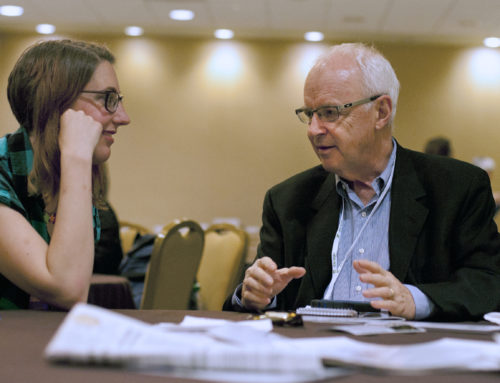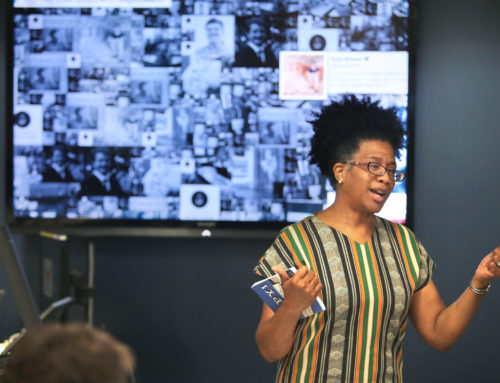Revised, November 2024
To be frank, I’m tired of judging newspapers and yearbooks from all over the country with photo credits such as “Photo by Google” or “Photo courtesy Flickr.” This just isn’t acceptable and advisers need to put a stop to it. But first we have to educate advisers. Neither Google nor Flickr own images. They simply serve as repositories for the images. As such, it is as inappropriate to credit Google or Flickr just as it is inappropriate to credit YouTube or Vimeo for video.
JEA’s guidelines, now more than a dozen years old, begin with: “Visual journalists work closely with editors, designers, producers and reporters to make sure visuals are integrated with narrative, telling stories, not just filling space. Videos, designs, photos, informational graphics and illustrations all enhance the media experience of readers or viewers.”
Producing a publication in print, online or in broadcast is a team effort. And without strong visuals, readers are likely to skip right on to the next visually enticing piece. In what Mario Garcia calls the journalism of interruptions, today’s ADD generation relies on visuals to move them throughout the message. As producers of the visual message, we rely on hits, view and readers for our original work. Ultimately, we rely on income from that original art. As such, as Jim Graham said in a publication I produced for the National Press Photographers Association back in 1999, “our images are our legacy.”
Protect that legacy.
Fight for the rights of the people who created the photo, the story, the layout, the video or the website. Obtain written permission before using something that you didn’t create.
It’s that simple. Don’t accept less.
Philosophy
Designers, photographers and illustrators on student media staffs are first and foremost journalists. All of the ethics that apply to reporters and editors also apply to visual journalists. All journalists must aspire to seek the truth, report comprehensively, provide balance and honor original thought.
Visual journalists play an important role on a staff as they provide another avenue for readers to access and understand news. Visual journalists are not decorators. Visual journalists should work closely with editors, designers, producers and reporters to make sure visuals are integrated with narrative, telling stories, not just filling space. Videos, designs, photos, informational graphics and illustrations all enhance the experience of the reader or viewer with media.
More information: National Scholastic Press Association Student Code of Ethics
More information: Society of Professional Journalists Code of Ethics
Creativity
We live in a visual society. Innovative and creative images and designs are easily accessible and widely available. Such resources should serve as resources and inspiration for student journalists who, finally, should rely upon their own ingenuity to come up with original concepts whether in print designs, online designs, infographics or photographs. Student publications should give priority to student-produced work, adhering to the appropriate laws and obtaining permission when necessary to reproduce works not created by students.
Copyright
The copyright laws of the United States (and most other countries) revolve around one basic principle: works are copyrighted (either by the artist or their employer) at the time of creation. Other entities that want to reproduce works created by other individuals must obtain written permission, in advance. Publication should not use any artwork created by individuals not on their staffs without written permission.
Copyright is a form of protection provided by the laws of the United States (title 17, U. S. Code) to the authors of “original works of authorship,” including literary, dramatic, musical, artistic, and certain other intellectual works. This protection is available to both published and unpublished works. Section 106 of the 1976 Copyright Act generally gives the owner of copyright the exclusive right to do and to authorize others:
- to reproduce the work in copies or phonorecords
- to prepare derivative works based upon the work
- to distribute copies or phonorecords of the work to the public by sale or other transfer of ownership, or by rental, lease, or lending
- to perform the work publicly, in the case of literary, musical, dramatic, and choreographic works, pantomimes, and motion pictures and other audiovisual works
- to display the work publicly, in the case of literary, musical, dramatic, and choreographic works, pantomimes, and pictorial, graphic, or sculptural works, including the individual images of a motion picture or other audiovisual work
- to perform the work publicly (in the case of sound recordings) by means of a digital audio transmission
More information: U.S. Copyright office
More information: Student Press Law Center material on copyright law
More information: University of Texas Copyright Crash Course
Fair Use
The U.S. copyright law does provide for special instances in which copyrighted materials can legally be used without permission from the owner under the doctrine of fair use.
The fair use of a copyrighted work for purposes such as criticism, comment, news reporting, teaching (including making multiple copies for classroom use), scholarship, or research, is not an infringement of copyright. In determining whether the use made of a work in any particular case is a fair use the factors to be considered include:
- the purpose and character of the use, including whether such use is of a commercial nature or is for nonprofit educational purposes;
- the nature of the copyrighted work;
- the amount and substantiality of the portion used in relation to the copyrighted work as a whole; and
- the effect of the use upon the potential market for or value of the copyrighted work.
In other words, for certain non-commercial, nonprofit educational purposes, including use in a student newspaper, on a news publication’s website or on a news broadcast (audio and video), a small portion of a film, audio recording or print publication, can be reproduced without first obtaining the written permission of the copyright holder, but editors should still give credit to and acknowledge the copyright holder as the source of the material.
More information: U.S. Copyright office statement on fair use
Creative Commons
The Internet makes possible the idea of universal access to research, education and culture, but legal and social systems do not always allow that idea to be realized. Legislators created copyright long before the emergence of the Internet, and current provisions in the laws can make it hard to legally perform actions users today take for granted, including copying, pasting, editing a source and posting to the Web. The default setting of copyright law requires users performing these actions, including artists, teachers, scientists, policymakers, producers of the mass media and private citizens, to receive explicit permission, granted in advance. To achieve the vision of universal access, Creative Commons helps individuals who create works provide a free, public, and standardized infrastructure that creates a balance between the reality of the Internet and the reality of copyright laws. There are six types of basic Creative Commons licenses all of which come with clearly identifying symbols. The most accommodating of these (CC BY) lets others distribute, remix, tweak, and build upon a work, even commercially, as long as they give credit for the original creation. The most restrictive of the licenses (CC BY-NC-ND) allows others to download works and to share them with others as long as they give credit. They can’t change them in any way or use them commercially.
In short, a Creative Commons license provides a user with a form of explicit, written permission, granted in advance, legally to use copyrighted material under the guidelines provided and with the appropriate credit.
More information: Creative Commons
Artificial intelligence
Artificial intelligence isn’t new. However, how tools such as Adobe Firefly and DALL-E are being used to create visuals is now commonplace.
It’s working its way into social media.
Michael Christopher Brown begins his photo essay, “90 miles,” by screaming, “THIS IMAGERY IS NOT REAL.”
He describes his project as “a post-photography AI reporting illustration experiment exploring historical events and realities of Cuban life that have, since 1961, motivated Cubans to cross the 90 miles of ocean separating Havana from Florida.”
It’s made it’s way into international photo competitions.
Boris Eldagsen submitted an artificial-intelligence-generated image to a photography contest as a “cheeky monkey” and sparked a debate about AI’s place in the art world.
However, in the last two years, artificial intelligence tools have made inroads into creating almost realistic-looking visual images, images that could easily, if used improperly, deceive a reader/viewer.
But in fact, photographer Boris Eldagsen said, images created with generative AI are very different from those created by photography.
Indeed, it’s sparked a new genre — “promptography.”
“Promptography is done with prompts. Photography is done with light,” Eldagsen said in a 2023 article on the BBC after revealing his photo contest entry was AI-generated and refusing to accept the award.
Promptography was the subject of an undergraduate research project by Bailey Graham and Casee Harl at Midwestern State University. They examined the question, “Can generative AI create an image suitable for use in college student media?”
They acknowledged, as Wael AbdAlmageed, a research associate professor of computer science at University of Southern California did, that “We as human species sort of grow up thinking that seeing is believing. That’s not true anymore. Seeing is not believing anymore.”
After a semester’s worth of research, these were their conclusions:
- AI is becoming more advanced and is rapidly evolving. While generative AI began in the 1960s, it wasn’t until 2014 that tools were created that could create convincingly authentic images, videos and audio of real people. It wasn’t until 2021 that AI platform DALL-E, intended for generating and editing unique artworks and photorealistic images, was launched. Now, dozens of free tools exist, making it easy for anyone to create images.
- The creators of AI-generated images don’t know what images the AI learned from. AI may be taking advantage of copyrighted source material. And it certainly doesn’t acknowledge any of the source material.
- The prompt matters. Type the same prompt into a different AI tool and get a different result. Type in the same prompt five minutes later and get a different result. Rearrange the words, get a different result. Further, these results can’t be replicated. Unless the user saves the image, it will never exist again.
Graham and Harl concluded, “Free generative AI tools are good at generating pretty pictures, not photojournalism.”
For now.
As the tools evolve, staff members will have to decide when and how they’ll permit the use of the images that are not, according to the U.S. government, copyrightable.
In the summer 2024 issue of Communication: Journalism Education Today, Jim Streisel suggested student staff members consider the following questions for their staff policy regarding artificial intelligence usage.
- What, specifically, should we never use AI for as a staff? What’s our “line” for using AI?
- What are acceptable uses of AI in our newsroom? What situations can you think of where AI might help us do our jobs more efficiently?
- How might AI manifest itself in different areas (e.g., photography, graphic design, writing, multimedia)? How might the guidelines be different for each of those areas?
- Does our audience need to know if information has been generated via AI? If so, what types of information? How should we cite AI-generated content if we decide to use it?
Credit
Whether it is through the use of a Creative Commons license, fair use or other written permission, students editors should give appropriate credit to all published works. It is never acceptable to give credit to a photo repository or search engine such as google.com, amazon.com, youtube.com, vimeo.com or flickr.com. Instead, obtain the appropriate permission from the owner of the copyright and give the copyright owner credit. Some samples of photo credits include:
- For staff photo: Staff photo by Jane Doe
- For staff photo: Photo by Jane Doe/News staff
- For submitted photo: Photo contributed by Jack Doe, used with permission, ©2012
- For photo with Creative Commons license: Photo contributed by Shawn Newsom, CC2012
- For movie still: Photo by John Doe, Paramount Studios, used with permission
- For movie still: Photo courtesy Disney Studios, used with permission
- For video clip: Video from “The Movie” courtesy 20th Century/Fox, used with permission
Photojournalism
By the nature of their profession, photojournalists document the lives of the people they cover. Their job is to share the truth, not to manipulate it.
As the National Press Photographers Association states in the preamble to its Code of Ethics: “Visual journalists operate as trustees of the public. Our primary role is to report visually on the significant events and varied viewpoints in our common world. Our primary goal is the faithful and comprehensive depiction of the subject at hand. As visual journalists, we have the responsibility to document society and to preserve its history through images.
“Photographic and video images can reveal great truths, expose wrongdoing and neglect, inspire hope and understanding and connect people around the globe through the language of visual understanding. Photographs can also cause great harm if they are callously intrusive or are manipulated.”
Student journalists should adhere to this philosophy and should endeavor to remain unbiased and objective.
More information: National Press Photographers Association Code of Ethics
Photo illustrations
When photojournalists use tools such as Adobe Photoshop to dramatically alter images, such images should be clearly false to the reader and clearly labeled, taking care never to mislead or to deceive the reader or viewer. As the preamble to the National Press Photographers Association’s Code of Ethics states: “Editing should maintain the integrity of the photographic images’ content and context. Do not manipulate images or add or alter sound in any way that can mislead viewers or misrepresent subjects.”
In addition, NPPA provides photojournalists with additional guidelines as part of that organization’s Digital Manipulation Code of Ethics: “[T]he guiding principle of our profession is accuracy; therefore, we believe it is wrong to alter the content of a photograph in any way that deceives the public. As photojournalists, we have the responsibility to document society and to preserve its images as a matter of historical record.”
The NPPA statement of principle concludes by stating, “Accurate representation is the benchmark of our profession. We believe photojournalistic guidelines for fair and accurate reporting should be the criteria for judging what may be done electronically to a photograph. Altering the editorial content … is a breach of the ethical standards recognized by the NPPA.”
Back in 1997, two University of Oregon professors, Tom Wheeler and Tim Gleason, provided some guidelines for photojournalists about whether and how to manipulate, to alter or to enhance images. Based on those guideline, photojournalists should answer the following questions when consider whether it is acceptable to manipulate an image for inclusion as part of a documentary news publication.
- Does the photograph represent what the photographer saw through the viewfinder? Is it a depiction of reality?
- Do the manipulations simply include routine cropping, color correction to restore the color balance to what appeared in the actual scene, or dodging/burning to improve reproduction quality?
Manipulations such as those above are considered routine would be appropriate even for documentary images when not carried to extremes. However, two more questions help refine what is acceptable and not.
- Is the proposed alternation obvious to the reader?
- Is the altered image obviously false?
With conviction, student photojournalists and editors should be able to answer “yes” to all of the questions before they should consider any manipulation for the purpose of reproducing a news/feature image or a photo illustration.
If the answer to any of the questions above is “no,” editors and photojournalists should:
- Adhere to the principle of reproducing photos that represent reality. Documentary news and feature photos should not be manipulated.
- Find alternative images that either represent reality or manipulate the image to the point where the manipulation obvious to the reader and obviously false.
While it is appropriate to label a photo illustration with the appropriate credit such as “Photo illustration by Tameka Brown,” labeling the image as an illustration alone is not enough to avoid deceiving the viewer.
Photo illustrations are not easy to create. Nor can they produced quickly or cheaply. Allow time — lots of time — to conceptualize, obtain the props and to produce the illustration. Photo illustrations should be clearly staged. A reader should never wonder whether the photo was real. In Ken Kobre’s Photojournalism: The Professionals’ Approach, Jay Koelzer, a photographer with the Rocky Mountain News, an award-winning newspaper that closed in 2009, said, “The photographer needs to take the reader somewhere outside the bounds of reality and the printed page. [M]ake people think. Never set up a photo illustration to mimic reality.”
Illustrations/artwork
Like photojournalists, artists producing infographics or simple graphics for news publications, whether online, in video or in print, have an obligation to provide their readers with information as well as to entice and to entertain the viewer. They should never produce designs or graphics that deceive or mislead the readers or viewers. The Society for News Design Code of Ethics stresses the importance of accuracy, honesty, fairness, inclusiveness and courage in all aspects of mass media coverage. “Logic and literalness, objectivity and traditional thinking have their important place, but so must imagination and intuition, responsible creativity and empathy.”
More information: Society of News Design Code of Ethics





Leave A Comment